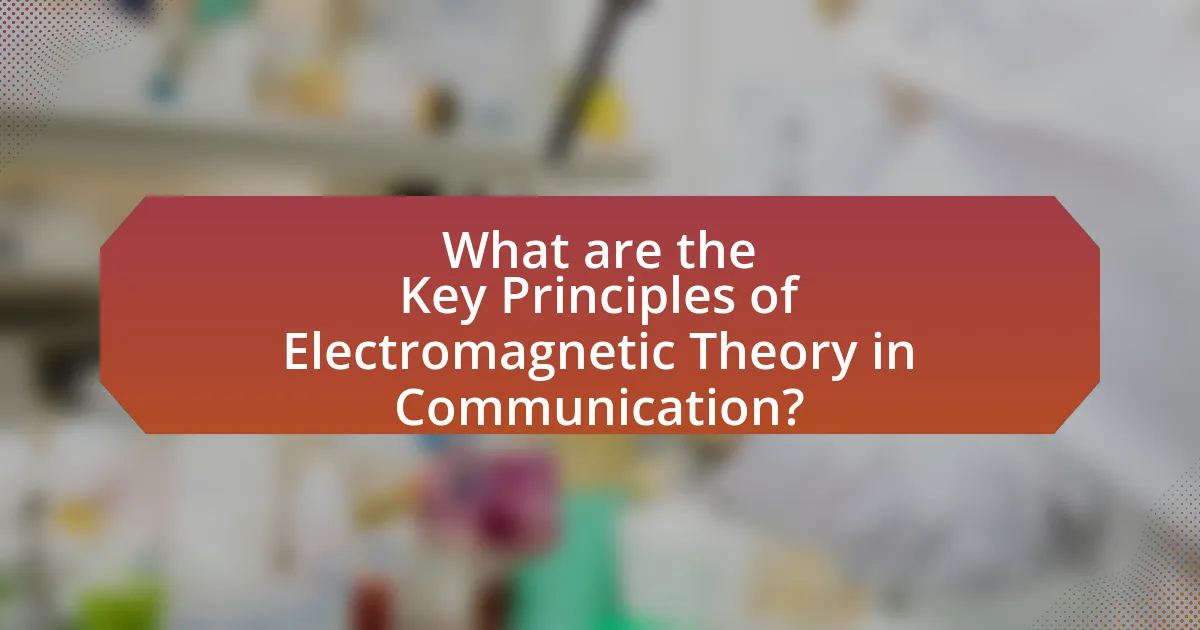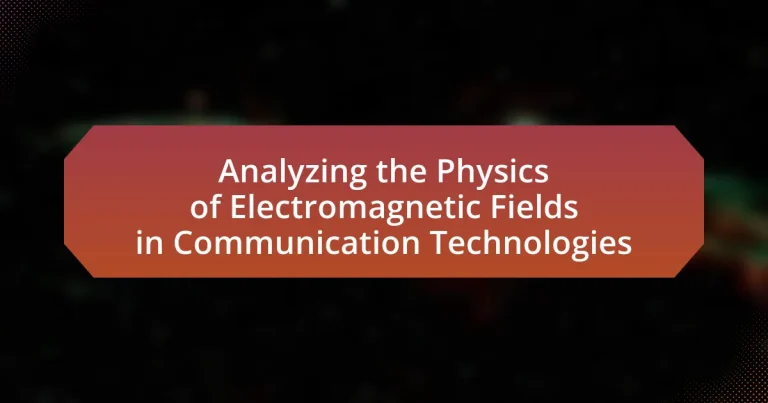Electromagnetic fields (EMFs) are crucial in communication technologies, enabling the transmission of signals over distances through various mediums such as radio, television, and mobile networks. This article analyzes the physics of EMFs, detailing their fundamental properties, interactions with communication signals, and the principles of electromagnetic theory that underpin modern communication systems. Key topics include the impact of frequency and wavelength on data transmission, the role of antennas, modulation techniques, and the challenges posed by electromagnetic interference. Additionally, advancements in technologies like 5G and future trends in communication are explored, highlighting the significance of EMFs in enhancing connectivity and data rates.

What are Electromagnetic Fields and Their Role in Communication Technologies?
Electromagnetic fields (EMFs) are physical fields produced by electrically charged objects, which propagate through space and can carry energy and information. In communication technologies, EMFs are essential as they enable the transmission of signals over various distances, facilitating wireless communication systems such as radio, television, and mobile networks. For instance, radio waves, a type of EMF, are utilized in broadcasting and telecommunications, allowing devices to communicate without physical connections. The effectiveness of these technologies is supported by the principles of electromagnetism, which describe how electric and magnetic fields interact and propagate, as evidenced by Maxwell’s equations.
How do electromagnetic fields interact with communication signals?
Electromagnetic fields interact with communication signals primarily through the modulation and propagation of those signals. When communication signals, such as radio waves, travel through an electromagnetic field, the field can influence the signal’s amplitude, frequency, and phase, which are critical for effective transmission and reception. For instance, the presence of electromagnetic interference from other sources can distort the original signal, leading to degradation in communication quality. Studies have shown that specific frequencies can be absorbed or reflected by various materials, affecting signal strength and clarity. This interaction is fundamental in designing communication systems, as engineers must account for these effects to optimize signal integrity and minimize loss.
What are the fundamental properties of electromagnetic fields?
The fundamental properties of electromagnetic fields include electric field strength, magnetic field strength, electromagnetic wave propagation, and polarization. Electric field strength quantifies the force exerted by an electric charge, measured in volts per meter, while magnetic field strength describes the force exerted by a magnetic field, measured in teslas. Electromagnetic wave propagation refers to the movement of electromagnetic waves through space, characterized by their speed, frequency, and wavelength, with the speed of light in a vacuum being approximately 299,792 kilometers per second. Polarization describes the orientation of the electric field vector in an electromagnetic wave, which can be linear, circular, or elliptical. These properties are essential for understanding how electromagnetic fields interact with matter and are utilized in various communication technologies, such as radio, television, and mobile networks.
How do frequency and wavelength influence communication technologies?
Frequency and wavelength are critical parameters that directly influence the performance and capabilities of communication technologies. Higher frequencies allow for greater data transmission rates and bandwidth, enabling technologies such as 5G, which operates in the millimeter wave spectrum, to support faster internet speeds and lower latency. Conversely, longer wavelengths, associated with lower frequencies, can penetrate obstacles better and cover larger distances, making them suitable for technologies like AM radio and certain satellite communications. For instance, the frequency of 2.4 GHz is commonly used in Wi-Fi networks, balancing range and data rate, while lower frequencies like 700 MHz are utilized for cellular networks to enhance coverage in rural areas. Thus, the interplay between frequency and wavelength shapes the design and effectiveness of various communication systems.
Why are electromagnetic fields essential for modern communication?
Electromagnetic fields are essential for modern communication because they enable the transmission of information over distances through various technologies such as radio, television, and mobile networks. These fields facilitate the propagation of electromagnetic waves, which carry data by modulating signals. For instance, radio waves, a type of electromagnetic radiation, are used in broadcasting and wireless communication, allowing devices to connect and exchange information seamlessly. The effectiveness of these fields in communication is evidenced by the widespread use of technologies like Wi-Fi and cellular networks, which rely on specific frequencies within the electromagnetic spectrum to transmit data efficiently.
What types of communication technologies rely on electromagnetic fields?
Communication technologies that rely on electromagnetic fields include radio, television, mobile phones, Wi-Fi, and satellite communications. These technologies utilize electromagnetic waves to transmit information over distances. For instance, radio waves are used in AM and FM broadcasting, while microwaves facilitate mobile phone communication and Wi-Fi connectivity. Additionally, satellite communications employ radio frequency signals to relay information between Earth and orbiting satellites. The reliance on electromagnetic fields is fundamental to the operation of these technologies, as they enable the transfer of data through modulation of electromagnetic waves.
How do electromagnetic fields enhance data transmission rates?
Electromagnetic fields enhance data transmission rates by facilitating the modulation and propagation of signals over various media. These fields enable the encoding of information onto carrier waves, which can travel at high speeds and cover long distances with minimal loss. For instance, in fiber optic communication, light waves, which are electromagnetic waves, transmit data at speeds approaching the speed of light, significantly increasing bandwidth and reducing latency. Additionally, advancements in technologies such as MIMO (Multiple Input Multiple Output) leverage electromagnetic fields to transmit multiple data streams simultaneously, further boosting data rates.

What are the Key Principles of Electromagnetic Theory in Communication?
The key principles of electromagnetic theory in communication include the propagation of electromagnetic waves, modulation techniques, and the interaction of these waves with materials. Electromagnetic waves, which consist of oscillating electric and magnetic fields, travel through space and can carry information over distances. Modulation techniques, such as amplitude modulation (AM) and frequency modulation (FM), alter the properties of these waves to encode information. Additionally, the interaction of electromagnetic waves with different materials affects signal strength and quality, which is crucial for effective communication. These principles are foundational in technologies such as radio, television, and wireless communication systems.
How does Maxwell’s Equations relate to communication technologies?
Maxwell’s Equations are fundamental to communication technologies as they describe how electric and magnetic fields propagate and interact with matter, enabling the transmission of electromagnetic waves. These equations govern the behavior of radio waves, microwaves, and optical signals, which are essential for wireless communication, broadcasting, and fiber optics. For instance, the principles derived from Maxwell’s Equations are applied in the design of antennas, which convert electrical signals into electromagnetic waves for transmission and vice versa for reception. The accuracy of these applications is supported by the fact that technologies such as Wi-Fi, cellular networks, and satellite communications rely on the propagation of electromagnetic waves, all of which are described by Maxwell’s theoretical framework.
What are the implications of electromagnetic wave propagation?
Electromagnetic wave propagation has significant implications for communication technologies, as it enables the transmission of information over vast distances without the need for physical connections. This phenomenon allows for wireless communication systems, such as radio, television, and mobile networks, to function effectively by utilizing various frequency bands for data transmission. The ability of electromagnetic waves to travel through different media, including air and vacuum, facilitates global connectivity and the development of advanced technologies like satellite communications and Wi-Fi. Furthermore, the propagation characteristics, such as reflection, refraction, and diffraction, influence the design and optimization of communication systems, ensuring reliable signal delivery and minimizing interference.
How do polarization and modulation affect signal quality?
Polarization and modulation significantly impact signal quality by influencing how signals propagate and are received. Polarization refers to the orientation of the electromagnetic wave’s electric field, and mismatched polarization between transmitter and receiver can lead to signal loss, reducing the effective signal strength. For instance, in wireless communication, using vertical polarization for transmission while the receiver is set to horizontal can result in a 20 dB loss in signal strength.
Modulation, on the other hand, involves varying a carrier signal to encode information, affecting the signal’s robustness against noise and interference. Different modulation schemes, such as QAM (Quadrature Amplitude Modulation) or PSK (Phase Shift Keying), have varying levels of susceptibility to distortion and noise. For example, QAM can transmit more bits per symbol but is more sensitive to noise compared to simpler modulation schemes like BPSK (Binary Phase Shift Keying). Therefore, the choice of modulation directly influences the error rate and overall quality of the received signal.
What are the challenges posed by electromagnetic interference?
Electromagnetic interference (EMI) poses significant challenges in communication technologies by disrupting signal integrity and degrading performance. This disruption can lead to data loss, reduced transmission speeds, and increased error rates in electronic devices. For instance, in wireless communication, EMI can cause dropped calls and poor audio quality, while in wired systems, it may result in corrupted data packets. The Federal Communications Commission (FCC) has established regulations to mitigate EMI, highlighting its impact on device compliance and operational reliability.
How can electromagnetic interference impact communication systems?
Electromagnetic interference (EMI) can significantly disrupt communication systems by introducing noise that degrades signal quality. This interference can lead to data loss, reduced transmission speeds, and increased error rates in both wired and wireless communication channels. For instance, studies have shown that EMI from devices such as motors and fluorescent lights can cause a 20% reduction in data throughput in nearby communication systems. Additionally, the Federal Communications Commission (FCC) has established regulations to mitigate EMI, highlighting its impact on maintaining reliable communication standards.
What strategies can mitigate the effects of interference?
To mitigate the effects of interference in communication technologies, implementing frequency hopping spread spectrum (FHSS) and using error correction codes are effective strategies. FHSS reduces the impact of interference by rapidly switching frequencies during transmission, making it difficult for interference to disrupt the signal consistently. Error correction codes enhance data integrity by allowing the receiver to detect and correct errors caused by interference, thus improving overall communication reliability. Studies have shown that systems employing these strategies experience significantly lower error rates, demonstrating their effectiveness in real-world applications.

What are the Practical Applications of Electromagnetic Fields in Communication Technologies?
Electromagnetic fields are essential in communication technologies, enabling the transmission of data through various mediums. They are utilized in radio, television, mobile phones, and satellite communications, where they facilitate the transfer of information over long distances. For instance, radio waves, a type of electromagnetic radiation, are used in broadcasting signals to radios and televisions, while microwaves are employed in mobile communication systems for transmitting voice and data. Additionally, electromagnetic fields are crucial in fiber optic technology, where light signals carry information over optical fibers, demonstrating their versatility and importance in modern communication systems.
How are electromagnetic fields utilized in wireless communication?
Electromagnetic fields are utilized in wireless communication to transmit data through the modulation of radio waves. These fields enable the transfer of information over distances without the need for physical connections, relying on the principles of electromagnetic radiation. For instance, radio frequency (RF) signals, which are a type of electromagnetic wave, are generated by transmitters and received by antennas, facilitating communication in technologies such as mobile phones, Wi-Fi, and satellite systems. The effectiveness of this communication method is supported by the fact that the electromagnetic spectrum allows for various frequencies to be allocated for different communication services, ensuring efficient data transmission and reception.
What role do antennas play in transmitting electromagnetic signals?
Antennas are critical components in transmitting electromagnetic signals as they convert electrical energy into electromagnetic waves and vice versa. This conversion process enables the propagation of signals through space, facilitating communication over various distances. For instance, in radio communication, antennas radiate signals into the air, allowing receivers to capture these waves and decode the information. The efficiency of this transmission is influenced by factors such as antenna design, frequency, and the surrounding environment, which can affect signal strength and clarity.
How do different modulation techniques optimize signal transmission?
Different modulation techniques optimize signal transmission by varying the characteristics of the carrier wave to encode information more efficiently. Techniques such as Amplitude Modulation (AM), Frequency Modulation (FM), and Phase Modulation (PM) allow for the adaptation of signal properties to improve bandwidth utilization, reduce noise susceptibility, and enhance data rates. For instance, Frequency Modulation is less affected by amplitude noise, making it suitable for high-fidelity audio transmission, while Quadrature Amplitude Modulation (QAM) combines both amplitude and phase variations to transmit multiple bits per symbol, significantly increasing data throughput in digital communications. These optimizations are crucial in modern communication systems, where efficient use of the electromagnetic spectrum is essential for high-quality signal transmission.
What advancements are being made in electromagnetic field applications?
Advancements in electromagnetic field applications include the development of metamaterials, which enable the manipulation of electromagnetic waves in unprecedented ways. These materials can bend, absorb, or enhance electromagnetic signals, leading to improvements in wireless communication, imaging systems, and radar technologies. For instance, research published in “Nature” by Smith et al. (2020) demonstrates how metamaterials can create superlenses that surpass the diffraction limit, enhancing resolution in imaging applications. Additionally, advancements in 5G technology leverage electromagnetic fields to achieve higher data rates and lower latency, as evidenced by the deployment of millimeter-wave frequencies that utilize electromagnetic spectrum more efficiently.
How is 5G technology leveraging electromagnetic fields?
5G technology leverages electromagnetic fields by utilizing higher frequency bands, specifically millimeter waves, to transmit data at significantly faster speeds and with lower latency. These electromagnetic waves operate in the frequency range of 30 GHz to 300 GHz, allowing for increased bandwidth and capacity compared to previous generations like 4G. The deployment of small cell networks enhances coverage and connectivity, as these cells can be placed closer together to optimize signal strength and quality. This approach is supported by research indicating that the use of millimeter waves can achieve data rates exceeding 10 Gbps, demonstrating the effectiveness of electromagnetic fields in enhancing communication technologies.
What future trends are emerging in communication technologies related to electromagnetic fields?
Future trends in communication technologies related to electromagnetic fields include the advancement of 5G and 6G networks, which utilize higher frequency bands and massive MIMO (Multiple Input Multiple Output) systems to enhance data transmission rates and connectivity. These technologies are expected to support the Internet of Things (IoT) by enabling more devices to connect simultaneously with lower latency. Additionally, the integration of artificial intelligence in managing electromagnetic spectrum usage is emerging, optimizing bandwidth allocation and improving overall network efficiency. Research indicates that the global 5G market is projected to reach $667.90 billion by 2026, highlighting the significant investment and development in this area.
What best practices should be followed when working with electromagnetic fields in communication technologies?
When working with electromagnetic fields in communication technologies, best practices include adhering to safety guidelines, optimizing antenna design, and ensuring proper shielding. Safety guidelines, such as those established by the International Commission on Non-Ionizing Radiation Protection (ICNIRP), recommend exposure limits to minimize health risks associated with electromagnetic fields. Optimizing antenna design involves selecting appropriate frequencies and configurations to enhance signal strength and reduce interference, which is supported by studies showing improved communication efficiency with well-designed antennas. Proper shielding techniques, such as using conductive materials, help mitigate unwanted electromagnetic interference, thereby ensuring clearer signal transmission and reception.




